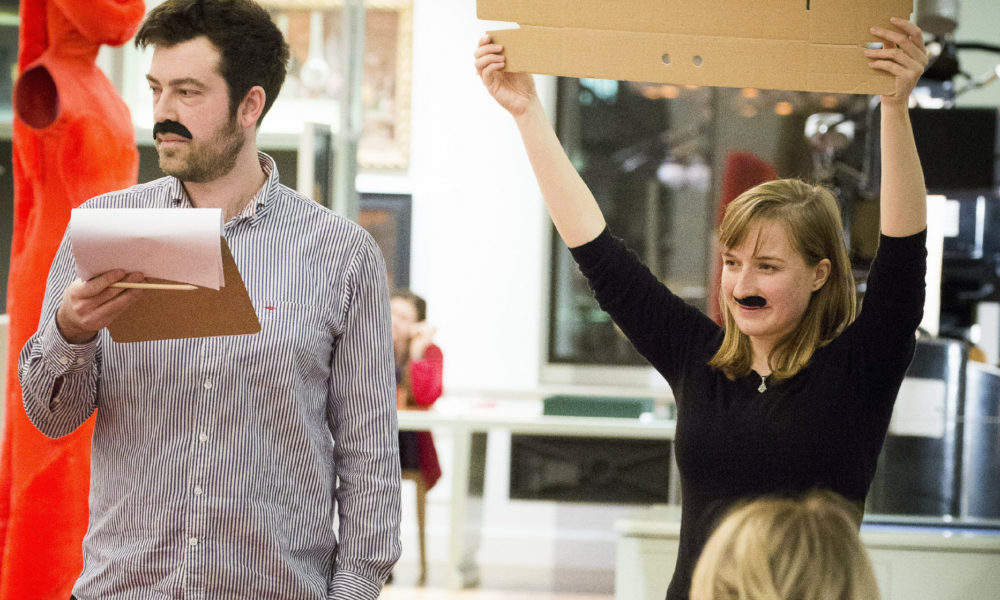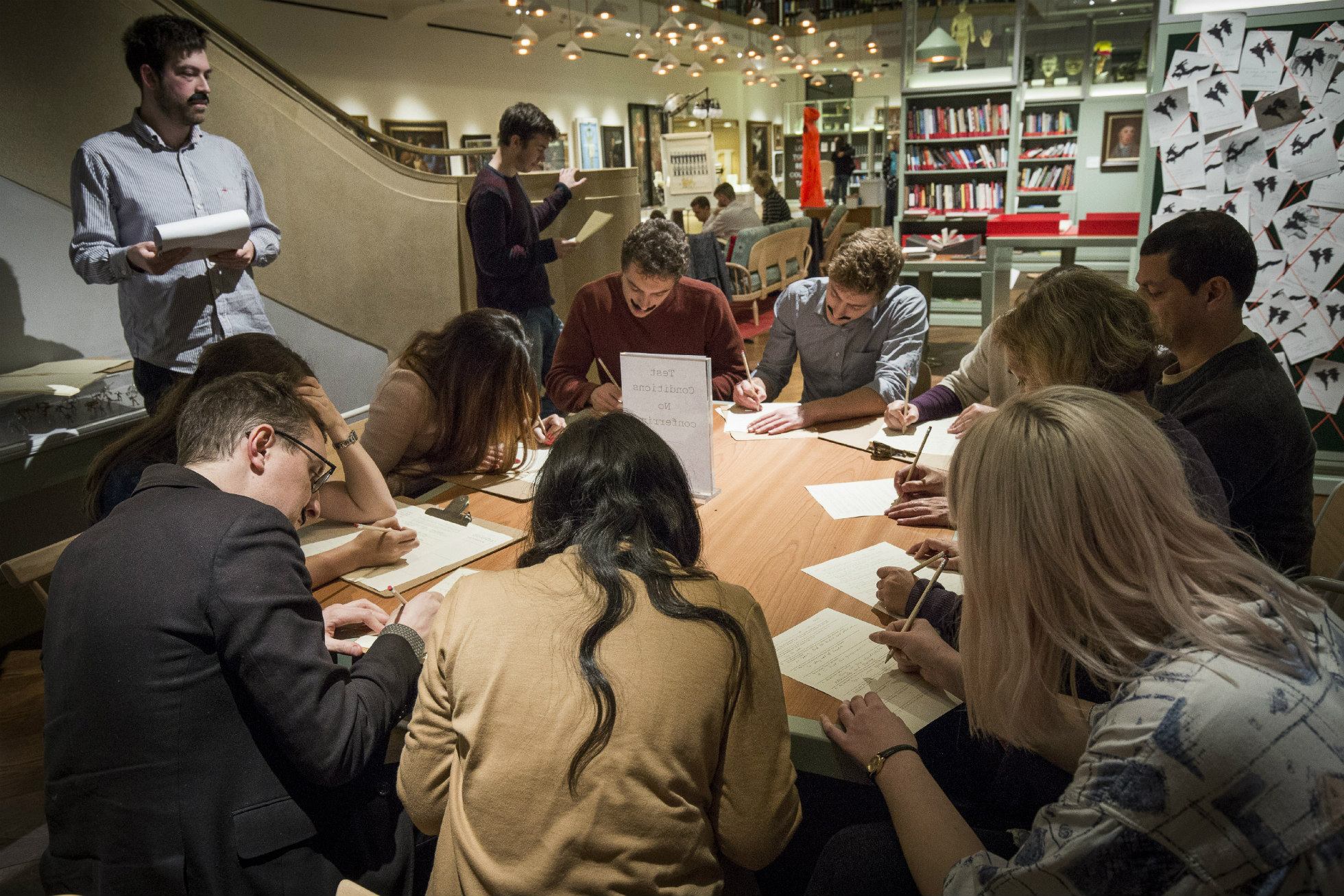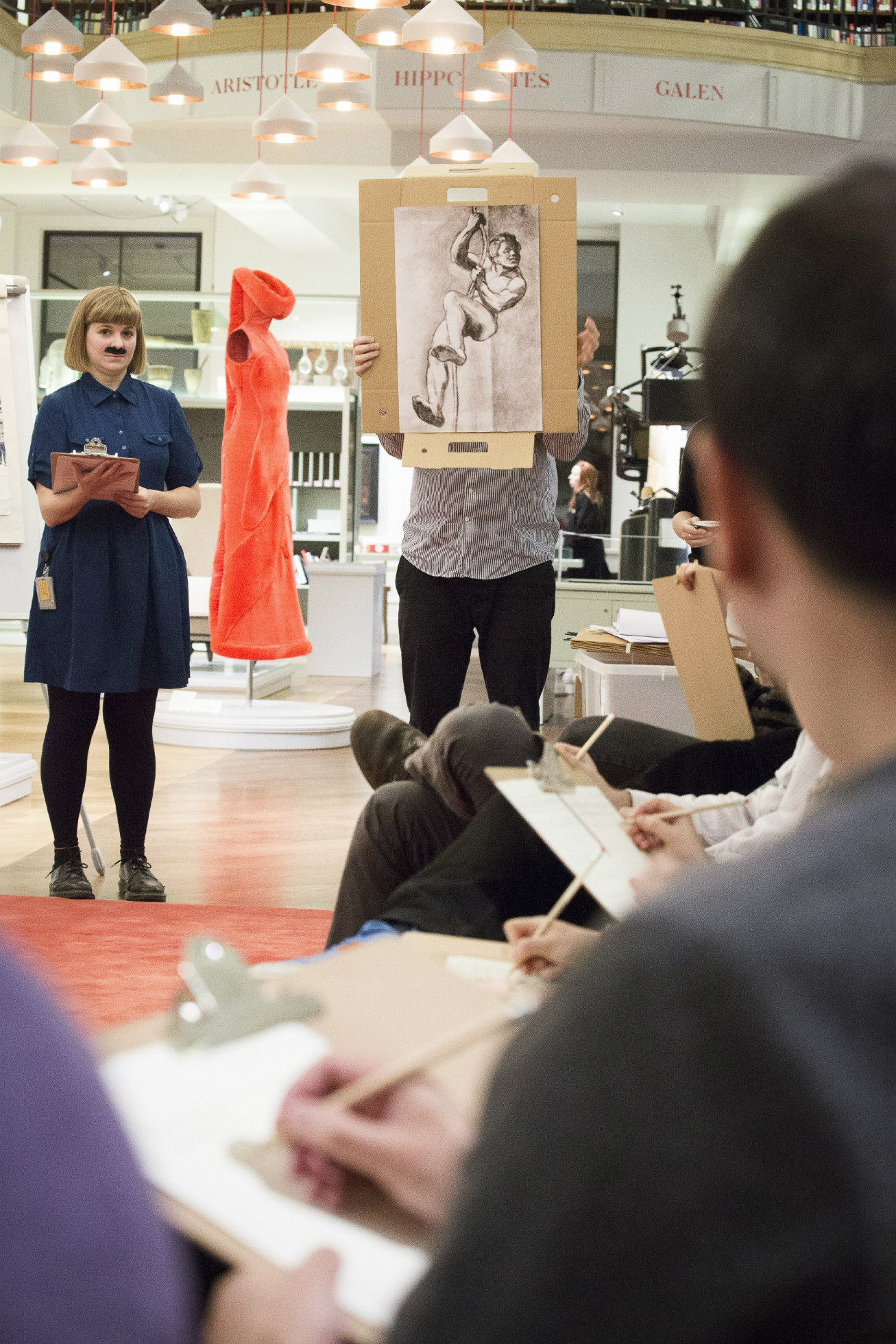
Recreating the War Officer Selection Boards – the Social Researcher’s experience
By Matt Gieve, Researcher at the Tavistock Institute of Human Relations
This blog is the last in a three part series about the experiences of an archivist, a historian and a social researcher in running the War Officer Selection Boards (WOSBs) in the Wellcome Library’s Reading Room last year. Read the archivist’s experience here and the historian’s here.
I joined the War Officer Selection Boards (WOSBs) team later than the other members. Plans for the event at Wellcome Library were already underway but colleagues thought that the subject would sit well with my background in psychology and were keen that a representative of current Institute staff be included.
While I’d known of the Institute’s involvement in the War Officer Selection Boards for some time, as part of the Institute’s creation myth, passed between the generations of staff, I’d never seen the tests themselves, so I encountered them as you might a distant relative of whom you’d heard stories, at once both new and familiar. Indeed the most striking sense I had of the tests as they were unveiled, newly printed in typewriter script on tea stained paper was one of familiarity. I was reminded of the endless IQ and non-verbal reasoning tests associated with securing extra-time in public exams: (“What word comes next in this series? Which polygon is the odd one out?”). Another task conjured memories of a career aptitude tests I’d undertaken as a 6th former in a drafty sports hall (Librarian was to be my professional destiny, a good reason if any to be little suspicious of such tests). Still more, the group tests were reminiscent of team building exercises to which though I have not been subject myself, have been sufficiently satirised in sitcoms to feel familiar. In talking with Alice and Elena the historian and archivists that made up the rest of the team, I learned that this familiarity was not a coincidence. While the army stopped using the WOSBs tests after the war, many of the tests were taken up within government and industry and spread around the world, marking a stage in the dissemination of psychology beyond the psychiatric and educational settings, and a stepping stone into industrial and managerial domains. It was therefore hard to imagine how these test appeared to prospective officers in the early 40’s with little or no prior contact with psychology or psychologists. Particularly as this tests were used primarily with candidates drawn from the ranks, without old-school tie connections or university educations.
 Despite their greater exposure to psychological testing, once the events started It was remarkable to see members of the public take part, often only on the basis of having been sat in the Wellcome reading room when the event started. The group tasks particularly brought the tests to life. Participants were presented with the dilemma that must have confronted the real candidates; to what extent should one try to demonstrate one’s own skills and to what extent should one support others to participate; the individual versus the group. Notwithstanding a little social awkwardness around the group tasks, genuine expressions of cooperation and competition were quick to emerge in the group dynamics. While in the role of army psychologist, invigilating the Wamwig task (to build a wigwam out of paper string and garden doweling), my mind wondered to what my historical counterparts may have thought of our groups, who was able to bring the best out of their peers, who was obstructive to or distracting from the task, which participants showed leadership potential? It was clear that the tasks would be revealing of character an aptitude.
Despite their greater exposure to psychological testing, once the events started It was remarkable to see members of the public take part, often only on the basis of having been sat in the Wellcome reading room when the event started. The group tasks particularly brought the tests to life. Participants were presented with the dilemma that must have confronted the real candidates; to what extent should one try to demonstrate one’s own skills and to what extent should one support others to participate; the individual versus the group. Notwithstanding a little social awkwardness around the group tasks, genuine expressions of cooperation and competition were quick to emerge in the group dynamics. While in the role of army psychologist, invigilating the Wamwig task (to build a wigwam out of paper string and garden doweling), my mind wondered to what my historical counterparts may have thought of our groups, who was able to bring the best out of their peers, who was obstructive to or distracting from the task, which participants showed leadership potential? It was clear that the tasks would be revealing of character an aptitude.
 As the Wellcome events played out, I foundmyself surprised at the comparative gentleness or idiosyncrasy of the tests. Unconsciously my assumption had clearly been that psychological tests employed by the army, during the war, would be numerical affairs: hard numbers andcertainty; the direct ancestors of present day psychometric tests (“on a scale of 1-5 how much do you agree with the following statement”). Instead I found a series of impressionistic tests, requiring in some cases free associations and long written answers that would take as much skill deciphering as they would writing. Test such as the Thematic Apperception task that required candidates to describe in long hand scenarios depicted in a series pictures. Or whole group tasks such as the Group Discussion where groups would be presented with an object (in this case a polka-dotted tea pot) and asked to discuss it. As Alice explained, the judgment of the army psychologist in the interpretation of the tests was crucial and the results of no single test could qualify or disqualify a candidate. Only when taken in the round would the suite of tests give their verdict.
As the Wellcome events played out, I foundmyself surprised at the comparative gentleness or idiosyncrasy of the tests. Unconsciously my assumption had clearly been that psychological tests employed by the army, during the war, would be numerical affairs: hard numbers andcertainty; the direct ancestors of present day psychometric tests (“on a scale of 1-5 how much do you agree with the following statement”). Instead I found a series of impressionistic tests, requiring in some cases free associations and long written answers that would take as much skill deciphering as they would writing. Test such as the Thematic Apperception task that required candidates to describe in long hand scenarios depicted in a series pictures. Or whole group tasks such as the Group Discussion where groups would be presented with an object (in this case a polka-dotted tea pot) and asked to discuss it. As Alice explained, the judgment of the army psychologist in the interpretation of the tests was crucial and the results of no single test could qualify or disqualify a candidate. Only when taken in the round would the suite of tests give their verdict.
That this was the case, even in the army, even under the conditions of war, highlights the changes that have occurred in the intervening 75 years and the relative suspicion with which the social sciences must have been held in the mid-20th century. So pervasive has been the spread of psychology into all spheres of modern life that it can be easy to forget the relative recency of its emergence. Looking back to the WOSBs, it was science that had to prove its case against the more tried and tested method of human judgement. Reflecting on the contrast between then and now highlighted to me the many ways in which we now put our faith in standardised testing and statistical analysis above human judgment, which is now understood to bring with it a range of biases and propensities to errors, and the effect this shift has had and continues to have on our understanding of ourselves. Just as the advent of accurate time keeping devices modulated our experience of the day, so the use of psychological measures mean people increasingly understand themselves as made up of quantifiable attributes. Attributes such as extroversion or introversion combined to render personality types such as ENTP (“The Debater”) or an ISFJ (“The Defender”). While there may be managerial benefits to such quantification and while it can sometimes be reassuring to be told with the impeccable confidence of numbers something about oneself, I found myself identifying with the old-fashioned army officers, nostalgic for the recent past where common-sense and holistic judgements still held sway.